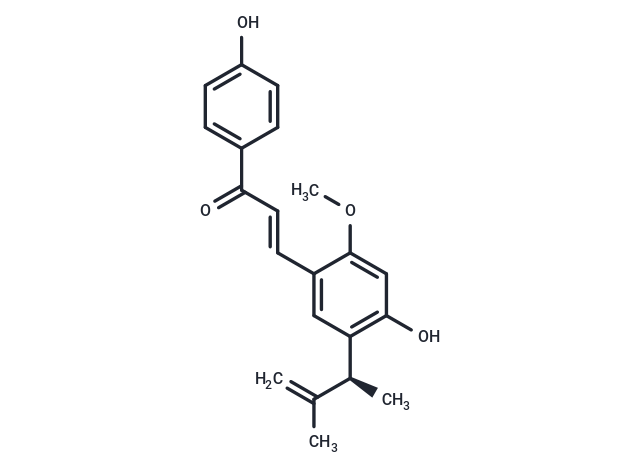Shopping Cart
- Remove All
 Your shopping cart is currently empty
Your shopping cart is currently empty

Licochalcone E is a potential LXRβ agonist.

| Pack Size | Price | Availability | Quantity |
|---|---|---|---|
| 1 mg | $98 | In Stock | |
| 5 mg | $342 | In Stock | |
| 10 mg | $548 | In Stock | |
| 25 mg | $872 | In Stock |
| Description | Licochalcone E is a potential LXRβ agonist. |
| In vitro | In this study, the quantitative pharmacophores were constructed by 3D-QSAR pharmacophore (Hypogen) method based on the LXRβ agonists. The optimal pharmacophore model containing one hydrogen bond acceptor, two hydrophobics and one ring aromatic was obtained based on five assessment indictors, including the correlation between predicted value and experimental value of the compounds in training set (correlation), α?cost of the models (α?cost), hit rate of active compounds (HRA), identification of effectiveness index (IEI) and comprehensive evaluation index (CAI). And the values of the five assessment indicators were 0.95, 128.65, 84.44%, 2.58 and 2.18 respectively. The best model as a query to screen the traditional Chinese medicine database (TCMD), a list of 309 compounds was obtained andwere then refined using Libdock program. Finally, based on the screening rules of the Libdock score of initial compound and the key interactions between initial compound and receptor, four compounds, demethoxycurcumin, isolicoflavonol, Licochalcone E and silydianin, were selected as potential LXRβ agonists[1] |
| Molecular Weight | 338.4 |
| Formula | C21H22O4 |
| Cas No. | 864232-34-8 |
| Smiles | COc1cc(O)c(cc1\C=C\C(=O)c1ccc(O)cc1)[C@@H](C)C(C)=C |
| Relative Density. | no data available |
| Storage | store at low temperature,keep away from moisture | Powder: -20°C for 3 years | In solvent: -80°C for 1 year | Shipping with blue ice. |

Copyright © 2015-2025 TargetMol Chemicals Inc. All Rights Reserved.